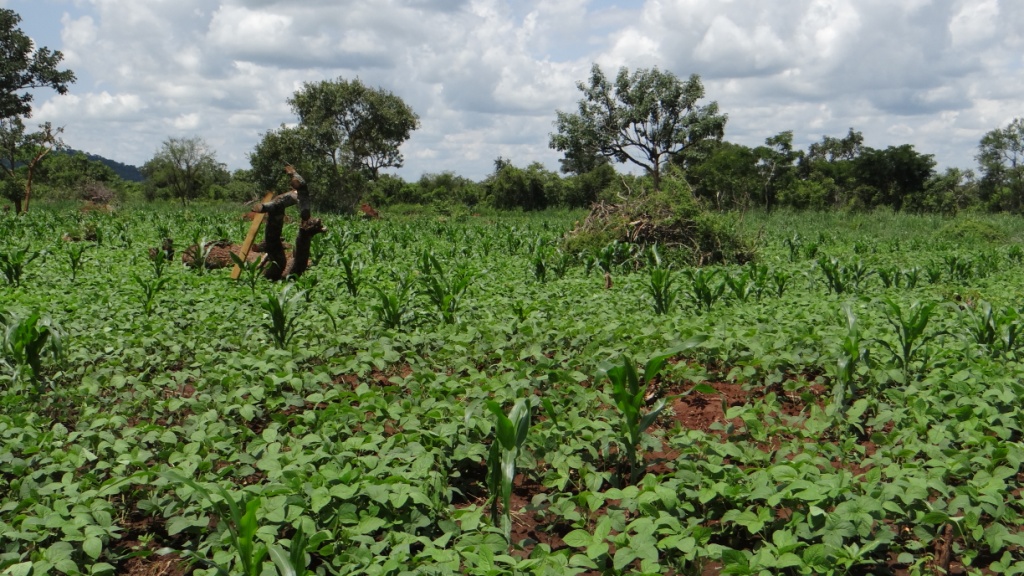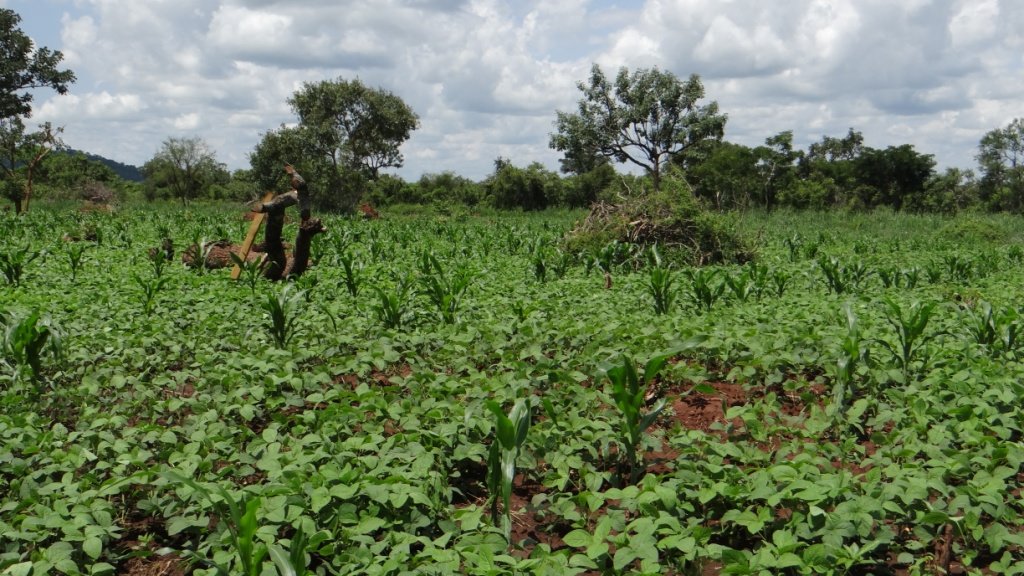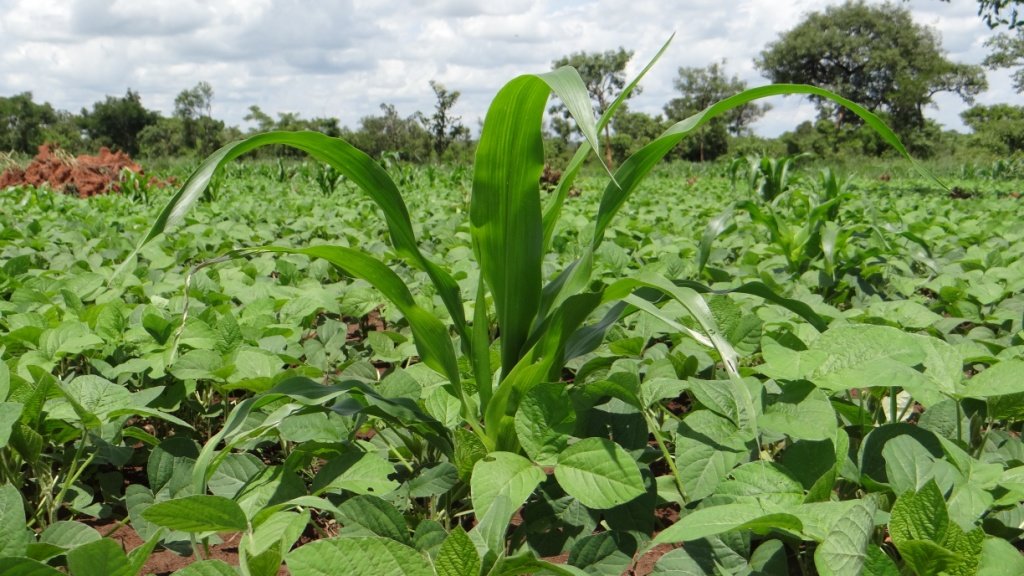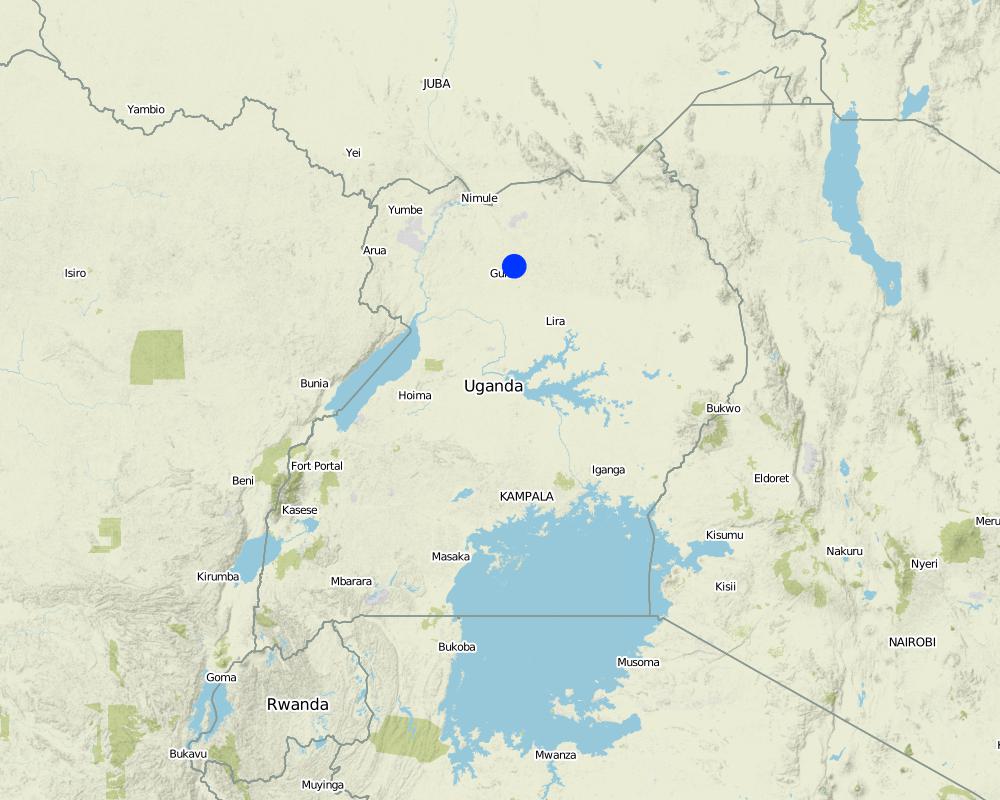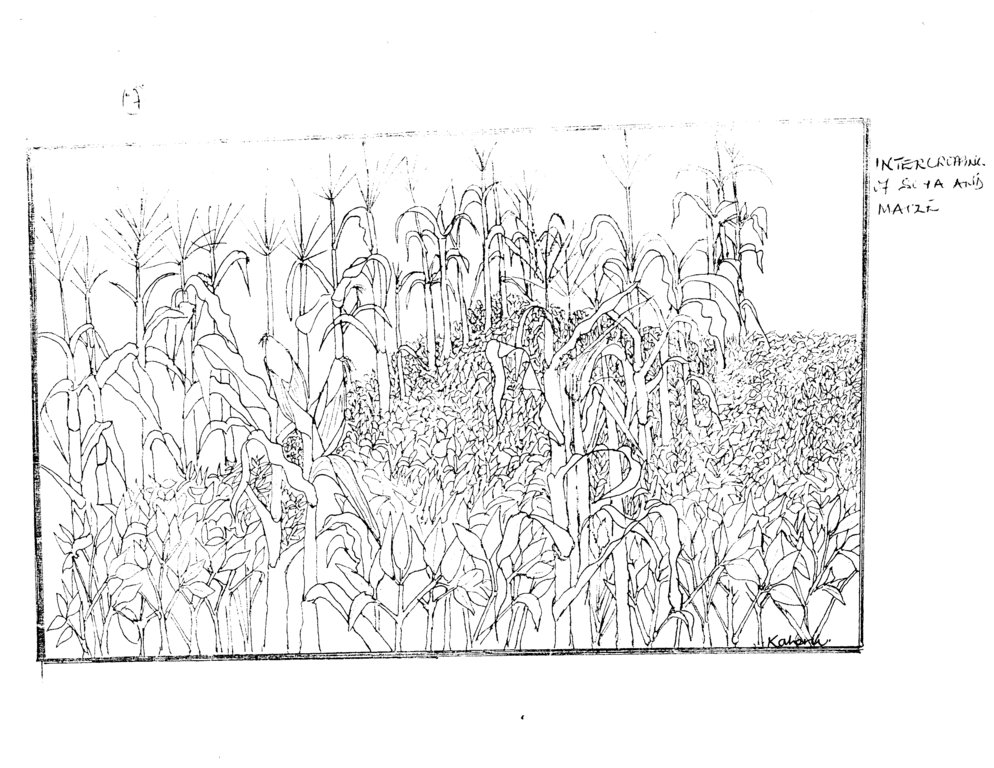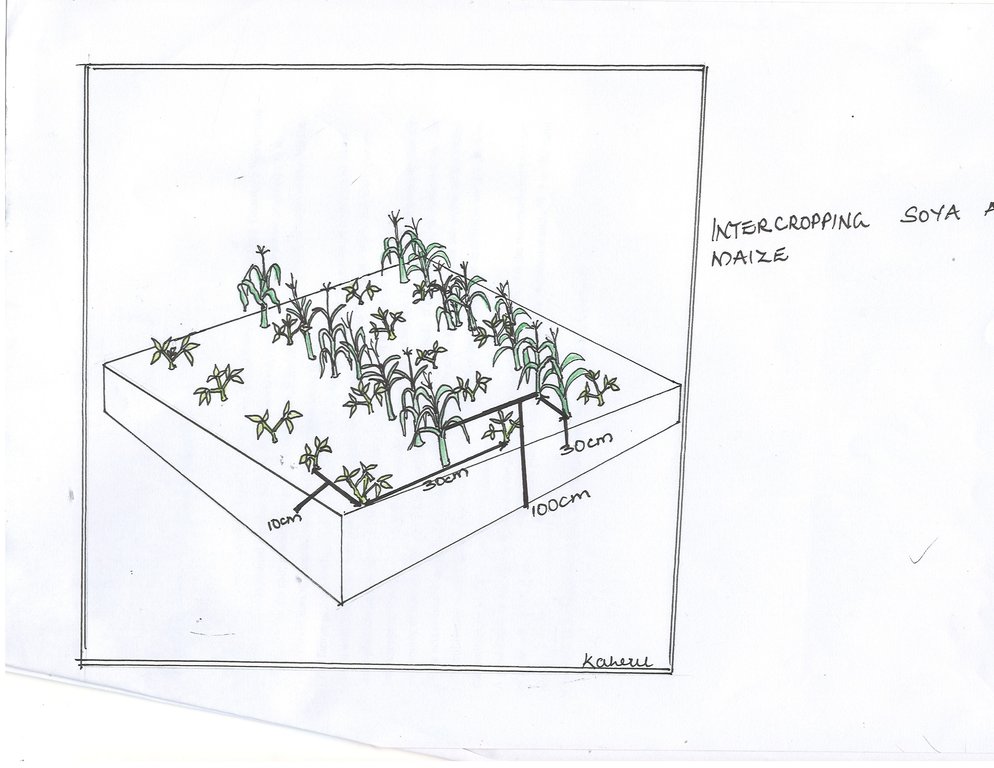Intercropping Soya and Maize [乌干达]
- 创建:
- 更新:
- 编制者: Kamugisha Rick Nelson
- 编辑者: JOY TUKAHIRWA, Richard Otto Kawawa, Sunday Balla Amale, Bernard Fungo
- 审查者: Donia Mühlematter, John Stephen Tenywa, Nicole Harari, Renate Fleiner, Stephanie Jaquet
Ribo Kodi Aryo
technologies_2815 - 乌干达
查看章节
全部展开 全部收起1. 一般信息
1.2 参与该技术评估和文件编制的资源人员和机构的联系方式
关键资源人
土地使用者:
Oloya John
Farmer
乌干达
有助于对技术进行记录/评估的项目名称(如相关)
Scaling-up SLM practices by smallholder farmers (IFAD)有助于对技术进行记录/评估的机构名称(如相关)
CDE Centre for Development and Environment (CDE Centre for Development and Environment) - 瑞士1.3 关于使用通过WOCAT记录的数据的条件
编制者和关键资源人员接受有关使用通过WOCAT记录数据的条件。:
是
1.4 所述技术的可持续性声明
这里所描述的技术在土地退化方面是否存在问题,导致无法被认为是一种可持续的土地管理技术?:
否
2. SLM技术的说明
2.1 技术简介
技术定义:
Soybean (Glycine max) and maize (Zea Mays) and planted together in the same field to increase soil fertility, production and household income.
2.2 技术的详细说明
说明:
Inter cropping is a practice where farmers cultivate two different crops in the same field. Usually, a leguminous crop (Soybean) is planted with a non-leguminous crop (Maize). The leguminous crop helps to fix nitrogen in to the soil; produce nitrogen generated from the decomposition of the rich crop residues, and adds nutrient to the soil. This in turn reduces the net demand for fertilizers based on nitrogen. The farmer planted soybean variety Maksoya 3N with a yield potential of 3,500 kg/ha; at a spacing of 10cm × 30cm with 2 seeds per hole and at a seed rate of 20 - 25 kg/acre. Longe 7H Maize variety was then sparsely inter-planted at a spacing of 30cm x 10m with 3 seeds per hole; in between the soybean.
Intercropping Maize and soybean is particularly important because soybean is mainly a cash crop and thus act as a source of income while the maize provides food for the household. If one crop fails, the other may survive hence acts as insurance against crop failure. Planting two crops in a field also reduces the workload associated with cultivating each crop in separate fields. The root systems of the two crops are at different soil layers hence competition for nutrients and water is minimal.
A good intercrop has the main crop and the minor crop. The main crop usually has the recommended seed rate of mono crop while the minor crop may be planted depending on its relative importance and effect on the main crop. However, in intercropping system, the yield potentials of each of the crops is realized.
2.3 技术照片
2.4 技术视频
注释、简短说明:
Video on inter cropping maize and soya
日期:
26/05/2017
位置:
Patuda Village, Paicho Parish -Paicho Sub-county , Gulu District
摄影师的名字:
Issa Aiga
2.5 已应用该技术的、本评估所涵盖的国家/地区/地点
国家:
乌干达
区域/州/省:
Northern Region,Uganda
有关地点的进一步说明:
Gulu District
具体说明该技术的分布:
- 适用于特定场所/集中在较小区域
Map
×2.6 实施日期
注明实施年份:
2014
如果不知道确切的年份,请说明大概的日期:
- 不到10年前(最近)
2.7 技术介绍
详细说明该技术是如何引入的:
- 通过土地使用者的创新
3. SLM技术的分类
3.1 该技术的主要目的
- 改良生产
- 降低灾害风险
- 适应气候变化/极端天气及其影响
- 创造有益的经济影响
3.2 应用该技术的当前土地利用类型

农田
- 一年一作
每年的生长季节数:
- 2
具体说明:
1st rainny season (march - june) and 2nd rainy season (august-Nov)
3.4 供水
该技术所应用土地的供水:
- 雨养
3.5 该技术所属的SLM组
- 改良的地面/植被覆盖
- 土壤肥力综合管理
3.6 包含该技术的可持续土地管理措施

农艺措施
- A1:植被和土壤覆盖层
- A2:有机质/土壤肥力

管理措施
- M3:根据自然和人文环境进行布局
- M4:活动时间安排的重大变化
- M5:物种组成的控制/变化
3.7 该技术强调的主要土地退化类型

化学性土壤退化
- Cn:肥力下降和有机质含量下降(非侵蚀所致)

物理性土壤退化
- Ps:有机土壤沉降,土壤沉降

生物性退化
- Bc:植被覆盖的减少
- Bq:数量/生物量减少
- Bl:土壤寿命损失
3.8 防止、减少或恢复土地退化
具体数量名该技术与土地退化有关的目标:
- 减少土地退化
4. 技术规范、实施活动、投入和成本
4.1 该技术的技术图纸
4.2 有关投入和成本计算的一般信息
具体说明成本和投入是如何计算的:
- 每个技术区域
注明尺寸和面积单位:
7 acres
其它/国家货币(具体说明):
UGX
如相关,注明美元与当地货币的汇率(例如1美元=79.9巴西雷亚尔):1美元=:
3400.0
注明雇用劳工的每日平均工资成本:
5000 per person per day
4.3 技术建立活动
| 活动 | 时间(季度) | |
|---|---|---|
| 1. | Land preparation | once in a year (March) |
| 2. | Planting | Once in a year (April) |
| 3. | Weeding | Once in a year (May) |
4.4 技术建立所需要的费用和投入
| 对投入进行具体说明 | 单位 | 数量 | 单位成本 | 每项投入的总成本 | 土地使用者承担的成本% | |
|---|---|---|---|---|---|---|
| 劳动力 | Labour for planting land | persons | 5.0 | 5000.0 | 25000.0 | 100.0 |
| 劳动力 | labour for applying seed | Persons | 5.0 | 5000.0 | 25000.0 | 100.0 |
| 设备 | Hoe | Pieces | 4.0 | 10000.0 | 40000.0 | 100.0 |
| 设备 | Watering can | Pieces | 4.0 | 100000.0 | 400000.0 | 100.0 |
| 设备 | Slasher | Pieces | 3.0 | 7000.0 | 21000.0 | 100.0 |
| 植物材料 | Soya bean | kgs | 120.0 | 2500.0 | 300000.0 | 100.0 |
| 植物材料 | Maize seeds | kgs | 5.0 | 2000.0 | 10000.0 | 100.0 |
| 技术建立所需总成本 | 821000.0 | |||||
4.5 维护/经常性活动
| 活动 | 时间/频率 | |
|---|---|---|
| 1. | Weeding | Once a season |
| 2. | Harvesting | Once a season |
4.6 维护/经常性活动所需要的费用和投入(每年)
| 对投入进行具体说明 | 单位 | 数量 | 单位成本 | 每项投入的总成本 | 土地使用者承担的成本% | |
|---|---|---|---|---|---|---|
| 劳动力 | labour | Persons | 10.0 | 5000.0 | 50000.0 | 100.0 |
| 技术维护所需总成本 | 50000.0 | |||||
注释:
Annual crops.
4.7 影响成本的最重要因素
描述影响成本的最决定性因素:
Labour takes most of the costs.
5. 自然和人文环境
5.1 气候
年降雨量
- < 250毫米
- 251-500毫米
- 501-750毫米
- 751-1,000毫米
- 1,001-1,500毫米
- 1,501-2,000毫米
- 2,001-3,000毫米
- 3,001-4,000毫米
- > 4,000毫米
指定年平均降雨量(若已知),单位为mm:
1200.00
农业气候带
- 半湿润
5.2 地形
平均坡度:
- 水平(0-2%)
- 缓降(3-5%)
- 平缓(6-10%)
- 滚坡(11-15%)
- 崎岖(16-30%)
- 陡峭(31-60%)
- 非常陡峭(>60%)
地形:
- 高原/平原
- 山脊
- 山坡
- 山地斜坡
- 麓坡
- 谷底
垂直分布带:
- 0-100 m a.s.l.
- 101-500 m a.s.l.
- 501-1,000 m a.s.l.
- 1,001-1,500 m a.s.l.
- 1,501-2,000 m a.s.l.
- 2,001-2,500 m a.s.l.
- 2,501-3,000 m a.s.l.
- 3,001-4,000 m a.s.l.
- > 4,000 m a.s.l.
说明该技术是否专门应用于:
- 不相关
5.3 土壤
平均土层深度:
- 非常浅(0-20厘米)
- 浅(21-50厘米)
- 中等深度(51-80厘米)
- 深(81-120厘米)
- 非常深(> 120厘米)
土壤质地(表土):
- 中粒(壤土、粉土)
土壤质地(地表以下> 20厘米):
- 中粒(壤土、粉土)
表土有机质:
- 中(1-3%)
5.4 水资源可用性和质量
地下水位表:
5-50米
地表水的可用性:
中等
水质(未处理):
良好饮用水
水的盐度有问题吗?:
否
该区域正在发生洪水吗?:
否
5.5 生物多样性
物种多样性:
- 中等
栖息地多样性:
- 中等
5.6 应用该技术的土地使用者的特征
定栖或游牧:
- 定栖的
生产系统的市场定位:
- 混合(生计/商业)
非农收入:
- 低于全部收入的10%
相对财富水平:
- 平均水平
个人或集体:
- 个人/家庭
机械化水平:
- 手工作业
- 畜力牵引
性别:
- 女人
- 男人
土地使用者的年龄:
- 青年人
- 中年人
说明土地使用者的其他有关特征:
The land user is also a carpenter where he earns some additional income to support his technology (buying seed, paying for labour and equipment).
5.7 应用该技术的土地使用者使用的平均土地面积
- < 0.5 公顷
- 0.5-1 公顷
- 1-2 公顷
- 2-5公顷
- 5-15公顷
- 15-50公顷
- 50-100公顷
- 100-500公顷
- 500-1,000公顷
- 1,000-10,000公顷
- > 10,000公顷
这被认为是小规模、中规模还是大规模的(参照当地实际情况)?:
- 中等规模的
注释:
Utilizes small area for cultivation.
5.8 土地所有权、土地使用权和水使用权
土地所有权:
- 个人,未命名
土地使用权:
- 个人
用水权:
- 社区(有组织)
5.9 进入服务和基础设施的通道
健康:
- 贫瘠
- 适度的
- 好
教育:
- 贫瘠
- 适度的
- 好
技术援助:
- 贫瘠
- 适度的
- 好
就业(例如非农):
- 贫瘠
- 适度的
- 好
市场:
- 贫瘠
- 适度的
- 好
能源:
- 贫瘠
- 适度的
- 好
道路和交通:
- 贫瘠
- 适度的
- 好
饮用水和卫生设施:
- 贫瘠
- 适度的
- 好
金融服务:
- 贫瘠
- 适度的
- 好
6. 影响和结论性说明
6.1 该技术的现场影响
社会经济效应
生产
作物生产
SLM之前的数量:
0.5 bag
SLM之后的数量:
3 bags
注释/具体说明:
Increased yield from soya and maize compared to before the technology.
作物质量
注释/具体说明:
Crops grow vigorously, good pod filling.
生产故障风险
注释/具体说明:
In case of one crop failure the other crop the other crop survives.
产品多样性
SLM之前的数量:
1 crop
SLM之后的数量:
2 crops
注释/具体说明:
More than one crop in the field.
生产区域
注释/具体说明:
Due to intercropping.
收入和成本
农业投入费用
注释/具体说明:
especially on seeds and labour
社会文化影响
食品安全/自给自足
生态影响
土壤
土壤覆盖层
注释/具体说明:
Maize stalks and soya wastes are left in the garden to provide mulch after decomposition.
养分循环/补给
注释/具体说明:
The leguminous crop helps to fix nitrogen into the soil; produce nitrogen generated from the decomposition of the rich crop residues, and adds nutrient to the soil.
6.3 技术对渐变气候以及与气候相关的极端情况/灾害的暴露和敏感性(土地使用者认为的极端情况/灾害)
气候有关的极端情况(灾害)
气象灾害
| 该技术是如何应对的? | |
|---|---|
| 局地雹灾 | 适度 |
6.4 成本效益分析
技术收益与技术建立成本相比如何(从土地使用者的角度看)?
短期回报:
轻度消极
长期回报:
轻度消极
技术收益与技术维护成本/经常性成本相比如何(从土地使用者的角度看)?
短期回报:
积极
长期回报:
积极
6.5 技术采用
- 11-50%
在所有采用这项技术的人当中,有多少人是自发的,即未获得任何物质奖励/付款?:
- 11-50%
注释:
The land user started on their own after learning from other land users. The knowledge acquired from the land users was enough to make start on their own.
6.6 适应
最近是否对该技术进行了修改以适应不断变化的条件?:
否
6.7 该技术的优点/长处/机会
| 土地使用者眼中的长处/优势/机会 |
|---|
| An assurance against crop failure - when one crop fails the other one steps in for food security and income. |
| Act as both a food and a cash crop. |
| 编制者或其他关键资源人员认为的长处/优势/机会 |
|---|
| The technology saves time for other activities in a year. |
| Can be replicated else where by other small scale and large scale farmers with similar or different pieces of land. |
6.8 技术的弱点/缺点/风险及其克服方法
| 土地使用者认为的弱点/缺点/风险 | 如何克服它们? |
|---|---|
| Competition for nutrients among crops and yield may not be like in mono culture. | Ensuring proper crop combination per inter crop. |
| Congestion among crops if the spacing is not done well | Ensuring proper spacing between crops. |
| 编制者或其他关键资源人员认为的弱点/缺点/风险 | 如何克服它们? |
|---|---|
| If the land user depends on inter cropping annual crops on may not be paying in the short run. |
Promote inter cropping with perennial crops like bananas for mulching using bananas. Diversification (Livestock and other crops like beans and banana). |
| The way the inter crop looks now is not a good enough as the land user needs advice from the extension worker on how to do inter cropping with the right spacings and the appropriate used crops. | A good intercrop skills should be provided such as including cover crops like beans and Mucuna Spp. |
7. 参考和链接
7.1 信息的方法/来源
- 实地考察、实地调查
01
- 与土地使用者的访谈
01
(现场)数据是什么时候汇编的?:
25/05/2017
链接和模块
全部展开 全部收起链接
无链接
模块
无模块


